 |
| Harry Pot/Anefo/Nationaal Archief/Wikimedia Commons |
This week, we’re devoting more time to flashbacks to state visits past — except this time, we’re going much further back in history! To kick off a week of royal-royal visits from decades past, we’ve got a look at the ultra-sparkling British state visit to the Netherlands in March 1958.
 |
| Queen Elizabeth II, March 1958 (Herbert Behrens/Anefo/Nationaal Archief/Wikimedia Commons) |
Before we dive into the program of the visit, let’s put everyone in the proper historical moment. In the spring of 1958, Queen Elizabeth II of the United Kingdom was a few weeks shy of her 32nd birthday. She’d been monarch for six years, and she and the Duke of Edinburgh had recently celebrated their 10th wedding anniversary. The couple had two children: the nine-year-old Duke of Cornwall (who would be made Prince of Wales a few months after this visit), and seven-year-old Princess Anne.
In recent years, rumors about unhappiness in the royal marriage had circulated, causing the royal couple to issue a rare public denial in 1957. The same year, the Queen had made it clear that Philip wasn’t going anywhere, granting him the title and style of a Prince of the United Kingdom. And there was also the other tormented royal romance of the Windsors during this era. Though Princess Margaret had publicly announced that she wouldn’t marry him in October 1955, Peter Townsend returned to Britain in March 1958 during the Queen and the Duke’s state visit to the Netherlands and had tea with Margaret. The papers speculated that his visit “appeared to have been timed to coincide with the absence” of the royal couple; the palace denied that.
 |
| Queen Juliana, March 1958 (Harry Pot/Anefo/Nationaal Archief/Wikimedia Commons) |
Across the channel, Queen Juliana of the Netherlands was almost 49 years old and a few months away from the 10th anniversary of her accession to the throne. She and Prince Bernhard had been married for 21 years, and they had four daughters: Princess Beatrix (20), Princess Irene (18), Princess Margriet (15), and Princess Christina (11), then known as Marijke. Two years earlier, the monarchy had been rocked by the Greet Hofmans scandal, which had caused a constitutional crisis and almost led Juliana and Bernhard to divorce. By 1958, both the monarchy and the marriage were on more stable ground.
 |
| Daan Noske/Anefo/Nationaal Archief/Wikimedia Commons |
The British state visit to the Netherlands was the latest in a packed schedule of diplomatic trips for Queen Elizabeth II. In less than a year, she had made visits to Portugal, France, Denmark, Canada, and the United States. The visit to the Netherlands began on Tuesday, March 25, 1958. The Queen and the Duke of Edinburgh had sailed from England to the Netherlands aboard the royal yacht Britannia, and they were greeted at the dock in Amsterdam by Queen Juliana, Princess Beatrix, and Princess Irene. Queen Elizabeth wore her Aquamarine Clips for the official arrival.
 |
| Harry Pot/Anefo/Nationaal Archief/Wikimedia Commons |
The royal party moved on to the Royal Palace in Amsterdam. There, Queen Elizabeth and Prince Philip walked across Dam Square to the National Monument for an official wreath-laying ceremony. The monument commemorates more than 200,000 Dutch lives that were lost between 1940 and 1945. Representatives from student volunteer corps of the universities of Amsterdam, Leiden, and Utrecht had gathered at the memorial for the ceremony, along with representatives of the wartime resistance movement.
 |
| Harry Pot/Anefo/Nationaal Archief/Wikimedia Commons |
After a moment of silence, a band in the square played “Abide with Me.” Before returning to the palace, the royal couple spoke with one of the veteran leaders of the Dutch resistance movement.
 |
| Anefo/Nationaal Archief/Wikimedia Commons |
On their return to the palace, the British and Dutch royals stepped on to the balcony to wave to the gathered crowds in the square below.
Inside the palace, Queen Elizabeth and Prince Philip were presented with a book by the Burgomaster, Mr. van Hall; the book contained special research that had been done to identify the subject of a Rembrandt painting in Buckingham Palace. This image gives you a nice look at the aquamarine clips on Elizabeth’s lapel.
 |
| Daan Noske/Anefo/Nationaal Archief/Wikimedia Commons |
Queen Elizabeth changed her outfit and brooch for the afternoon’s engagements, which began with a visit to the Rijksmuseum in Amsterdam. You’ll note the grand Cullinan III and IV Brooch pinned to her jacket here.
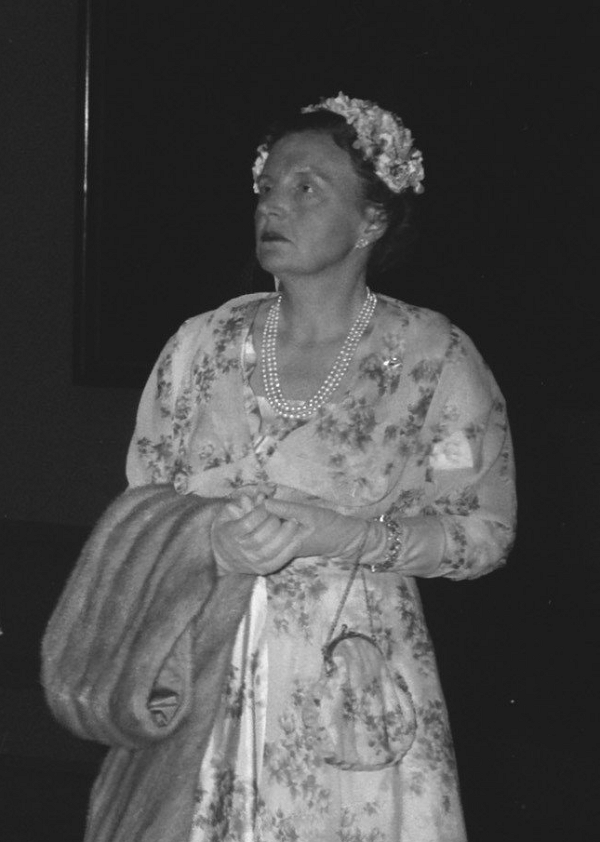 |
| Daan Noske/Anefo/Nationaal Archief/Wikimedia Commons |
Queen Juliana also changed into a floral outfit and pearls for the Rijksmuseum outing.
Queen Elizabeth’s brooch choice for the afternoon wasn’t an accident. Next, the royals drove to the Asscher Diamond Company’s workshop, where they viewed a British royal cypher set with more than 3500 diamonds. The Associated Press reported that Elizabeth and Juliana looked at the display, which reportedly cost upwards of half a million dollars, and then looked at each other. “What do you think?” Elizabeth asked, and, after looking at the security guard nearby, Juliana wryly replied, “Honesty is the best policy.” The report added, “Then, like any other women, the two monarchs giggled.”
In a touching moment during the visit to the workshop, Queen Elizabeth met Louis Asscher, the brother of Joseph Asscher, who had cut the great Cullinan Diamond fifty years earlier. She took off the brooch and showed it to him, jokingly calling it “Granny’s Chips” — the first time that tongue-in-cheek nickname had been used in public.
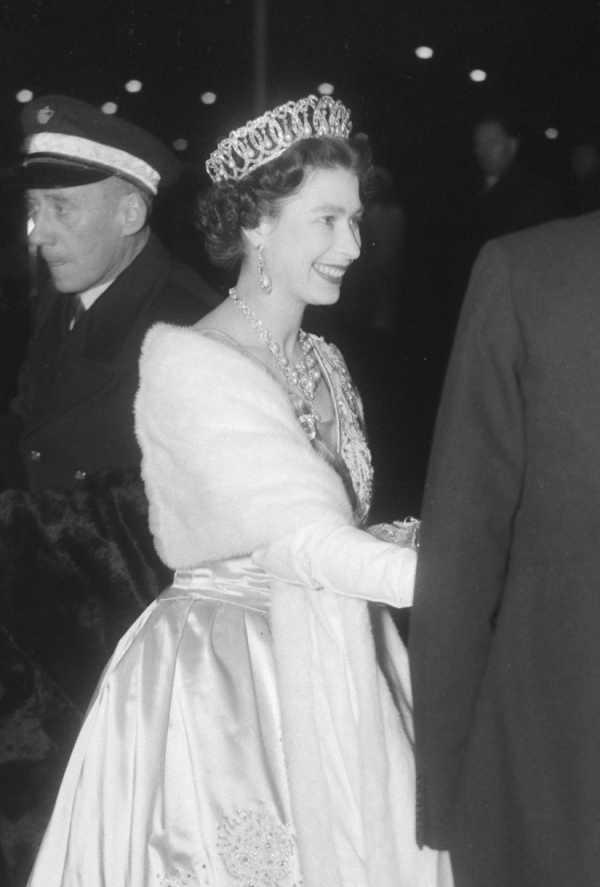 |
| Joop van Bilsen/Anefo/Nationaal Archief/Wikimedia Commons |
On the first night of the state visit, the royals piled on their finery for a state banquet at the Royal Palace in Amsterdam. Queen Elizabeth wore diamonds and pearls: the Vladimir Tiara, Queen Victoria’s Golden Jubilee Necklace, and the Gloucester Pendant Earrings.
 |
| Joop van Bilsen/Anefo/Nationaal Archief/Wikimedia Commons |
She secured the sash of the Order of the Netherlands Lion with the Kensington Bow Brooch. (I think I also spot the Edinburgh Wedding Bracelet on her right wrist.)
 |
| Ian Gavan/Getty Images |
The gown that she wore for the banquet was a rather spectacular creation by Sir Norman Hartnell. The Illustrated London News described the dress as “a brilliant gown in sky-blue and primrose-yellow,” with “a swath of blue sweeping across the primrose of the skirt.” The report added that both “skirt and bodice carried embroidery of ruched lace, re-embroidered with aquamarines and pale topazes.” The dress remains in the Royal Collection today, and it was displayed at Buckingham Palace as part of the “Fashioning a Reign: 90 Years of Style from The Queen’s Wardrobe” exhibition in the summer of 2016.
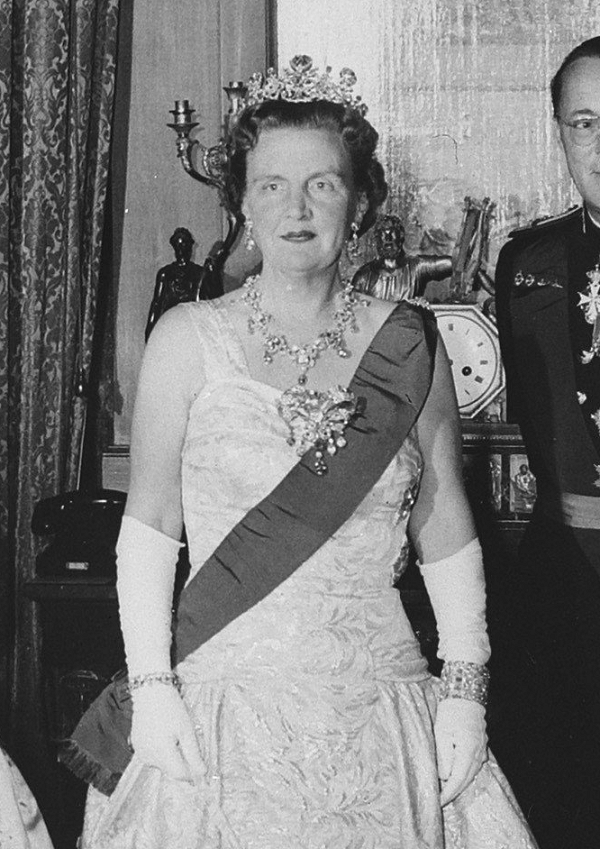 |
| Anefo/Nationaal Archief/Wikimedia Commons |
For the banquet, Queen Juliana wore a very appropriate set of jewels: the Stuart Parure, which includes the famous Stuart Diamond (which, of course, has major British royal heritage).
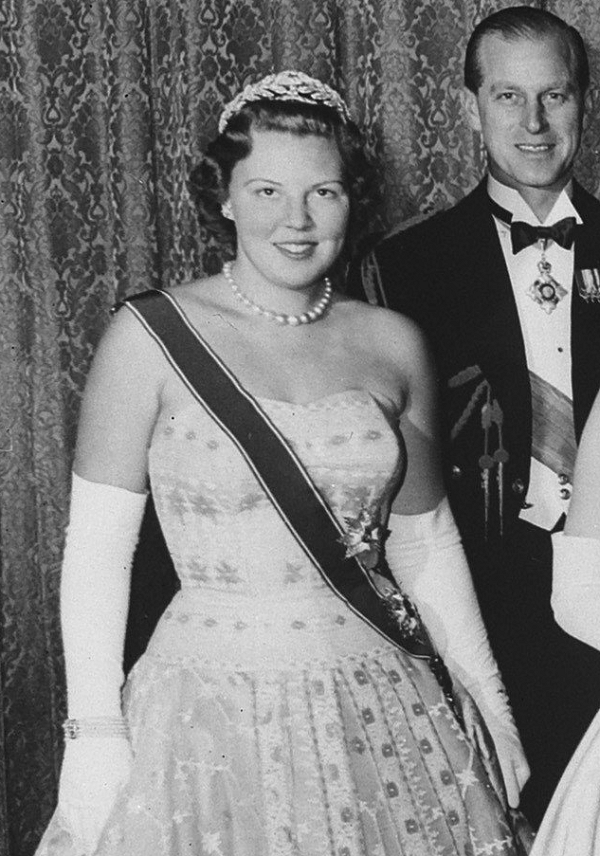 |
| Anefo/Nationaal Archief/Wikimedia Commons |
Princess Beatrix wore age-appropriate sparkle: the Dutch Laurel Wreath Tiara and an elegant single strand of pearls. You’ll also note a pearl bracelet on her right wrist.
 |
| Anefo/Nationaal Archief/Wikimedia Commons |
Princess Irene also wore one of the smaller Dutch royal sparklers: the Ears of Wheat Tiara. She paired it with small drop earrings and a diamond necklace.

After eating a dinner that included “Friendship Soup” as one of the courses, both monarchs gave speeches. Queen Elizabeth noted that she hoped the cooperation between the two nations would serve as “a symbol of the desire of all people for a new era of friendship and understanding throughout the world.” When the banquet had ended, the party moved to the Royal Concertgebouw, where the orchestra played Johan Wagenaar’s Cyrano de Bergerac Overture and Elgar’s Enigma Variations. Nothing beats the lighting at a concert house for maximum diamond sparkle — look at those jewels glittering away in the royal box during the performance!
 |
| Herbert Behrens/Anefo/Nationaal Archief/Wikimedia Commons |
On Wednesday, March 26, the second day of the visit began with the royal couples splitting off to cover multiple engagements. While Prince Bernhard and Prince Philip marveled at a new Dutch helicopter at the industrial fair in Utrecht, Queen Juliana and Queen Elizabeth headed to Aalsmeer for a visit to the famous flower auction.

Both monarchs participated in the bidding during the auction — much to the delight of Queen Elizabeth. She bought a bunch of carnations, while Queen Juliana bid for orchids.
 |
| Herbert Behrens/Anefo/Nationaal Archief/Wikimedia Commons |
For her morning engagements, which also included a brief visit to the fishing port of Scheveningen, Queen Elizabeth wore Empress Marie Feodorovna’s Sapphire Brooch. The monarchs met up with their husbands for luncheon at Huis ten Bosch Palace in The Hague, where Queen Elizabeth and Prince Philip also had the chance to meet Queen Juliana’s mother, 77-year-old Princess Wilhelmina (who had reigned as Queen Wilhelmina until 1948).
 |
| Herbert Behrens/Anefo/Nationaal Archief/Wikimedia Commons |
After an outfit change, the visit continued in the afternoon with a stop at the Gemeentemuseum (now known as the Kunstmuseum Den Haag), an art museum in The Hague. The royals viewed a special exhibition, “The Age of Shakespeare,” which included many items on loan from British collections.
 |
| Herbert Behrens/Anefo/Nationaal Archief/Wikimedia Commons |
They also attended a reception for guests from the British commonwealth. Unfortunately, I haven’t been able to find a single frame, photograph or video, from these afternoon engagements that gives us a clear view of Queen Elizabeth’s brooch. All I can tell you for certain is that it’s one of her smaller brooches, and it’s set with gemstones.
While in The Hague, the Queen and the Duke concentrated on their royal engagements, but during their visit to the city an American reporter pushed her press secretary, Jock Colville, to give them a statement regarding Peter Townsend’s unexpected return to Britain and his meeting with Princess Margaret. He replied, archly, “You would be wrong to picture this in the framework of a great romance. It isn’t, you know.”
 |
| Harry Pot/Anefo/Nationaal Archief/Wikimedia Commons |
But there’s absolutely no mistaking the jewels worn by Queen Elizabeth for that evening’s dinner, given by the Dutch government at the Trêveszaal in the Binnenhof, the Dutch government complex in The Hague.
 |
| Harry Pot/Anefo/Nationaal Archief/Wikimedia Commons |
Queen Elizabeth dazzled in diamonds for this dinner, including Queen Alexandra’s Kokoshnik, the Greville Chandelier Earrings, and her own Diamond Festoon Necklace. She secured the sash of the Order of the Netherlands Lion with Queen Mary’s Lover’s Knot Brooch. (It also appears that she again wore the Edinburgh Wedding Bracelet.)
The Queen’s dress for the occasion was a gorgeous deep blue velvet, as you can see in the color photograph above.
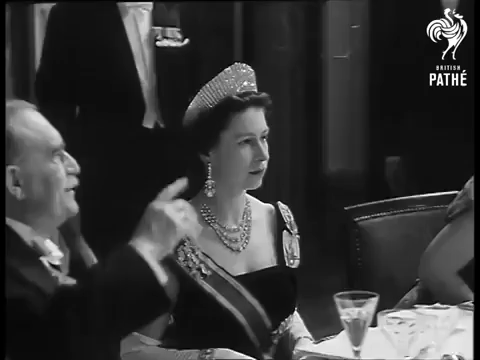
This is one of my favorite outings of Queen Alexandra’s Kokoshnik — it just sparkled so magnificently in the historic room, which dates to the end of the seventeenth century.
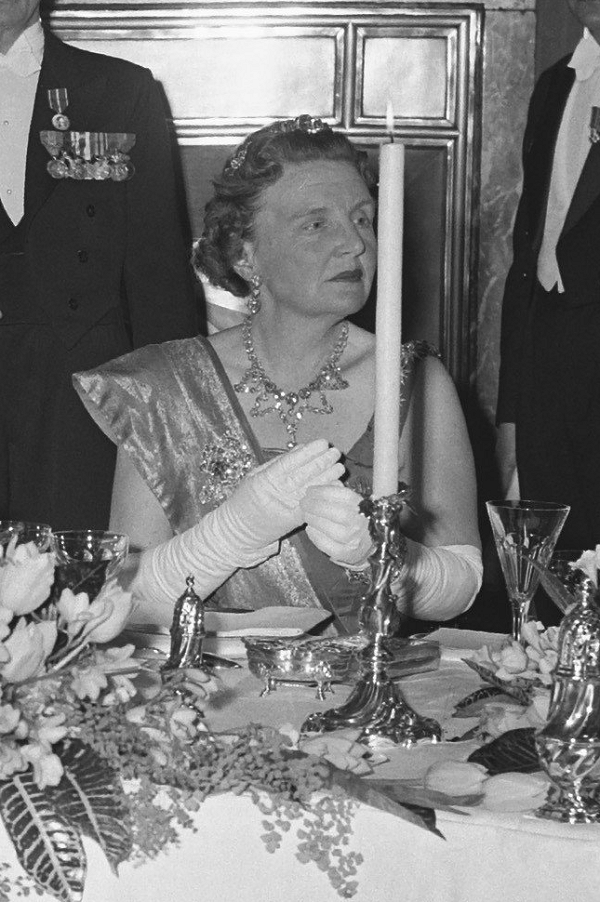 |
| Harry Pot/Anefo/Nationaal Archief/Wikimedia Commons |
Queen Juliana also sparkled in diamonds for the dinner. She wore the Dutch Diamond Bandeau with the family’s Diamond Festoon Necklace and other diamond jewels. Interestingly, she wore the sash of the Order of the Garter wrapped around the left strap of her gown, pinning it in place on the front and back with the family’s diamond stars.
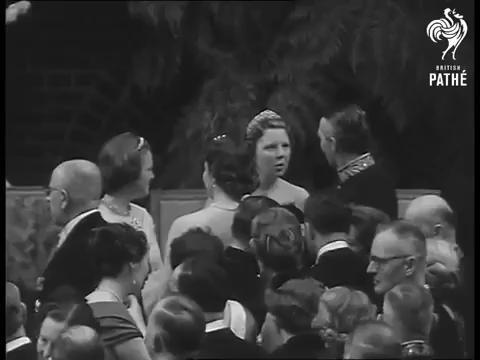
Princess Beatrix and Princess Irene repeated the same tiaras from the previous night, wearing the Dutch Laurel Wreath Tiara and the Dutch Ears of Wheat Tiara, respectively. This time, Irene wore the fabulous Dutch Diamond Trellis Necklace as well.
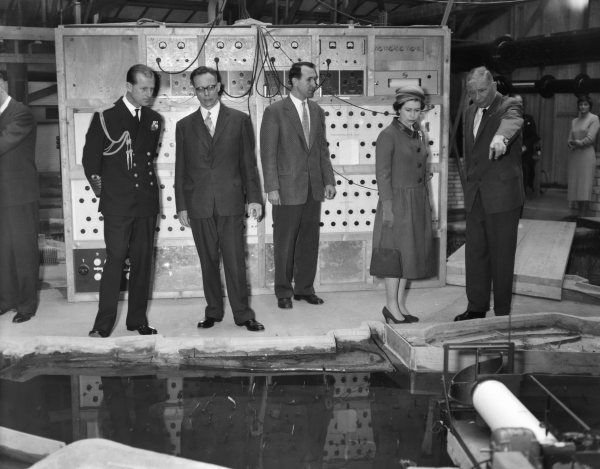 |
| Harry Pot/Anefo/Nationaal Archief/Wikimedia Commons |
Thursday, March 27 was the final day of the three-day state visit. The royals began in Delft, where they visited a very necessary Dutch institution: the Hydrological Laboratory. Even as Queen Elizabeth was introduced to the technology the Dutch were using to deal with their sea issues, the press wanted to keep the story focused on Princess Margaret and Peter Townsend. The Associated Press reported, “At Delft, in Holland, Queen Elizabeth smiled cordially as she began the final day of a state visit. But newsmen with her said she occasionally looked preoccupied.” Even so, the report added, “Courtiers here and [in] Delft emphasized repeatedly that, as they saw it, the reunion was simply a meeting between ‘old friends.'”
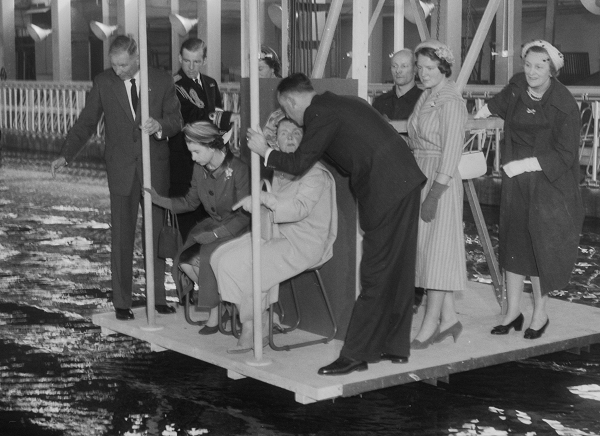 |
| Harry Pot/Anefo/Nationaal Archief/Wikimedia Commons |
Anyway! The visit gave us some of the most unusual royal engagement photos I’ve seen from this era, as Queen Elizabeth, Queen Juliana, and Princess Beatrix boarded a moving platform that hovered over the water. Every time I see this photo I gasp at the possibility that the Williamson Pink Diamond Brooch could tumble right in!
 |
| Anefo/Nationaal Archief/Wikimedia Commons |
Next, the party continued on to their final stop of the visit, Rotterdam. There, the royals visited a local housing estate, stopping by the flat of the Dodement family. They also toured a local building center, viewing a model of the city, and made a stop at St. Mary’s, a local English church.
 |
| Anefo/Nationaal Archief/Wikimedia Commons |
The Williamson Pink Diamond Brooch sparkled on Queen Elizabeth’s outfit for the final day of the visit.
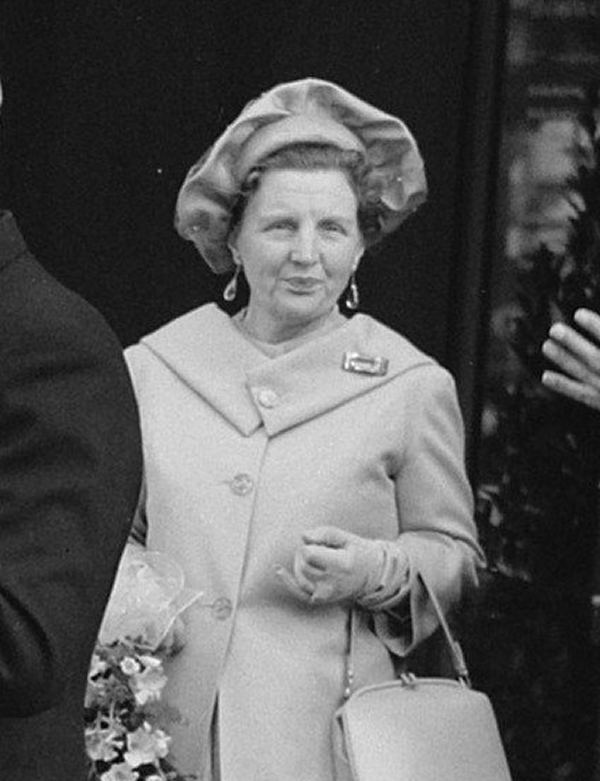 |
| Anefo/Nationaal Archief/Wikimedia Commons |
Queen Juliana also reached for major gemstones, wearing her aquamarine briolette drop earrings and her rectangular aquamarine brooch.
 |
| Anefo/Nationaal Archief/Wikimedia Commons |
The royal party was hosted for a luncheon at Rotterdam’s Town Hall, where the Queen and the Duke received gifts for Prince Charles and Princess Anne. They also made an appearance on the building’s balcony.
 |
| Anefo/Nationaal Archief/Wikimedia Commons |
A carriage procession took the royals to the Parkkade in Rotterdam, where Britannia was docked. They said their official farewells as Queen Elizabeth and Prince Philip returned to the ship.

But the visit wasn’t over just yet. The Queen and the Duke hosted a private dinner for the Dutch royals on board Britannia that night, complete with tiaras and fireworks. (It appears that the Queen wore the Girls of Great Britain and Ireland Tiara with the Brazilian Aquamarine Necklace; it’s not clear what the Dutch royal ladies wore, but they donned tiaras, too.) After the party had ended, Britannia set sail for England — and the lingering Townsend rumors. Irritated by press who had been trailing him during his time back in London, Townsend issued a statement through his attorney just as the royal couple were returning home: “There are no grounds for supposing that my seeing Princess Margaret in any way alters the situation declared specifically in the princess’ statement in the autumn of 1955.” He wasn’t kidding. Townsend married his Belgian girlfriend, Marie-Luce Jamagne, in 1959, and Margaret married Antony Armstrong-Jones the following year.
Leave a Reply